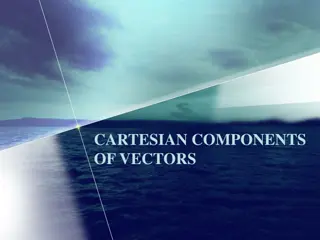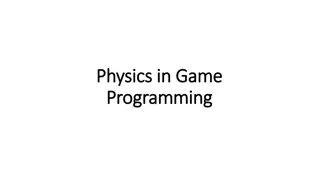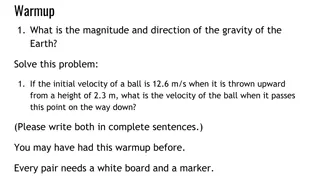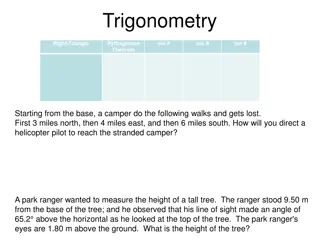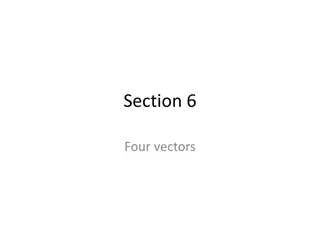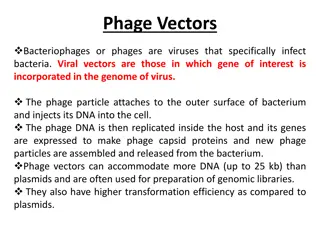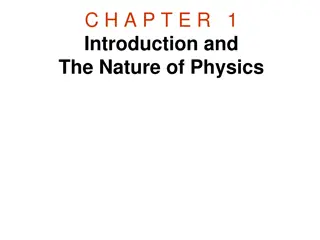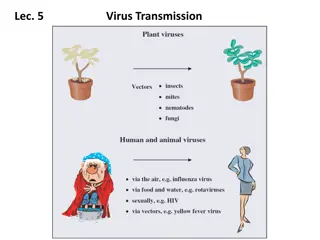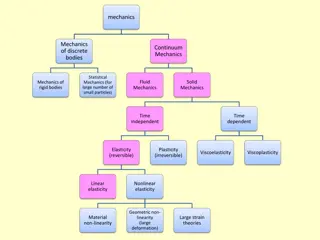Understanding Vectors in AP Physics C: Mechanics
Explore the fundamental concepts of vectors in AP Physics C: Mechanics, including scalar vs. vector quantities, vector operations, and vector multiplication. Discover the significance of vectors in explaining and predicting physical phenomena through graphical methods and mathematical equations. Dive into topics such as displacement, velocity, and vector components to enhance your understanding of motion and calculations in the physical world.
Download Presentation

Please find below an Image/Link to download the presentation.
The content on the website is provided AS IS for your information and personal use only. It may not be sold, licensed, or shared on other websites without obtaining consent from the author. Download presentation by click this link. If you encounter any issues during the download, it is possible that the publisher has removed the file from their server.
E N D
Presentation Transcript
AP Physics C - Mechanics Vectors https://njctl.org/video/?v=LOIS4Jjz8vo
Table of Contents: Vectors Vectors and Scalars Basic Vector Operations and Vector Components Vector Multiplication
Vectors and Scalars Return to Table of Contents https://njctl.org/video/?v=CH_ls98fpXg
Introduction Vectors are key in understanding physical phenomena in that they give us a mathematical format for explaining, predicting and calculating what happens in the physical world using equations created by scientists over several centuries.
Introduction A brief review of vectors and how to add and subtract them using both a graphical method and vector components is presented next. The key addition in this unit is the multiplication of vectors. Vectors are not just multiplied as we do with real numbers. There are three types: multiplying a vector by a scalar (simple) multiplying two vectors and getting a scalar - the vector dot product (a little trickier) multiplying two vectors and getting a vector - the vector cross product or curl (can be intimidating)
Scalar versus Vector Each of the physical quantities we encounter can be categorized as either a scalar quantity or a vector quantity. A scalar quantity can be completely specified by its magnitude (size) with appropriate units, such as mass, speed, and time. A vector quantity has both a magnitude and a direction associated with it, such as velocity and acceleration. A vector quantity is often represented with an arrow over the letter, such as .
1 Which of the following quantities are vectors? I Time A I and III II Speed B I and V III Velocity C II and III D III and IV IV Distance Answer E E III and V V Displacement https://njctl.org/video/?v=3bNucY62_MI
Drawing a Vector A vector is always drawn with an arrow at the tip indicating the direction, and the length of the line representing the magnitude. Displacement is the distance away from your initial position, along with a direction. It does not account for the actual distance you moved. https://njctl.org/video/?v=VxbYD-NJyGA
Magnitude and Direction of a Vector anti-parallel All of these vectors have the same magnitude, but vector B runs anti- parallel to vectors A1 and A2 and is denoted as -A1 and -A2. Vectors are also represented by bold type. The negative of a Vector is defined as the vector that gives zero when added to the original vector. The negative of is .
Equality of Vectors If two vectors are parallel, and have the same magnitude, such as p1p2 || p3p4 and |A1| = |A2| then A1 = A2. p1p2 || p3p4 Two vectors are equal if they have the same magnitude and the same direction. A vector may be translated as long as its orientation isn't changed without affecting the vector. If a vector is rotated, it becomes a new vector since its direction changes.
Basic Vector Operations and Vector Components Return to Table of Contents https://njctl.org/video/?v=4Mk6Bim0t28
Vector Addition Methods Tail to Tip Method Place the tail of the second vector B to the tip of the first vector A and draw a line vector from the tail of first vector Ato the tip of the second vector B. Vector C is called the resultant vector.
Examples: Adding Vectors Tail to Tip
Vector Addition Methods Parallelogram Method Place the tails of each vector against one another. Finish drawing the parallelogram with dashed lines and draw a diagonal line from the tails to the other end of the parallelogram to find the vector sum.
Subtracting Vectors Subtracting vectors is achieved by the addition of the negative of a vector. A - B is achieved byA + (-B)
Multiplication of Vectors by Scalars A vector V can be multiplied by a scalar c. The result is a vector cV which has the same direction as V. However, if c is negative, it changes the direction of the vector. V 2V - V c = -1/2 c = 2 c = 1
2 Which of the following is a true statement? A It is possible to add a scalar quantity to a vector. BIf a vector is translated parallel to itself, it no longer behaves like the original vector. Answer E CTwo non zero vectors can never be added together to give a resultant zero vector. DRotating a vector about an axis passing through the tail of the vector does not change the vector. E Vectors can be added geometrically. https://njctl.org/video/?v=nSsGW4D4cSk
3 If a car undergoes a displacement of 3 km North and another of 4 km East, what is the magnitude of the displacement? A 4 km 5 2 km B 5 km Answer 3 km x C 4 3 km B D 7 km E 6 km https://njctl.org/video/?v=OPv1zFr9htE
4 If a car undergoes a displacement of 3 km North and another of 4 km East, what is the total distance traveled? A 5 2 km 4 km Answer B 7 km 3 km B x C 5 km D 4 km E 3 km https://njctl.org/video/?v=o6oUQFq8l0E
5 Solve for o A 45 4 km o B 75 o o C 53 3 km x Answer D 37 o C E 25 https://njctl.org/video/?v=vRnosCvm5l4
Vector Components v vy vy vx https://njctl.org/video/?v=XJAKXRJYrZY
Multiple Vectors When adding multiple vectors, first find the components of vectors in x and y directions, then add x components and y components respectively. These additions provide the x and y components of the resulting vector sum. Bx By Cy Ax Cx The magnitude of D is: Ay Dy The angle that D makes with the x axis is: Dx
6 The components of vector A are given as follows: The magnitude of A is: Answer A B C D E 4.2 8.4 11.8 18.9 70.9 B https://njctl.org/video/?v=yS5Z8Ntttew
7 The components of vectors A and B are given as follows: Answer B Solve for the magnitude of A B C D E 5 17 17 10 8 https://njctl.org/video/?v=U7ode9WR9oM
8 The components of vector A are given as follows: The angle measured counter-clockwise from the +x axis to vector A, in degrees, is: o o o A B C D E 339 200 122 21 159 Answer E o o https://njctl.org/video/?v=LoBSmNw-0DA
9 The components of vectors A and B are given as follows: Answer The magnitude of B - A, is: B A B C D E 10 4.9 2.8 9.7 25 https://njctl.org/video/?v=kj7AaCR4AmY
10 The magnitude of B is 5.2. Vector B lies in the 4th quadrant and forms a 30o angle with the x axis. The components of B, Bx and By are: A B C Answer D C E https://njctl.org/video/?v=eYLlNsl77zI
11 Vector A is equal to vector B added to vector C. What is the magnitude of vector A? y A B C D E 2.6 -1.8 -3.4 1.6 -2.5 5.3 x 30O Answer 45O 6 D https://njctl.org/video/?v=TZrcumybuf0



